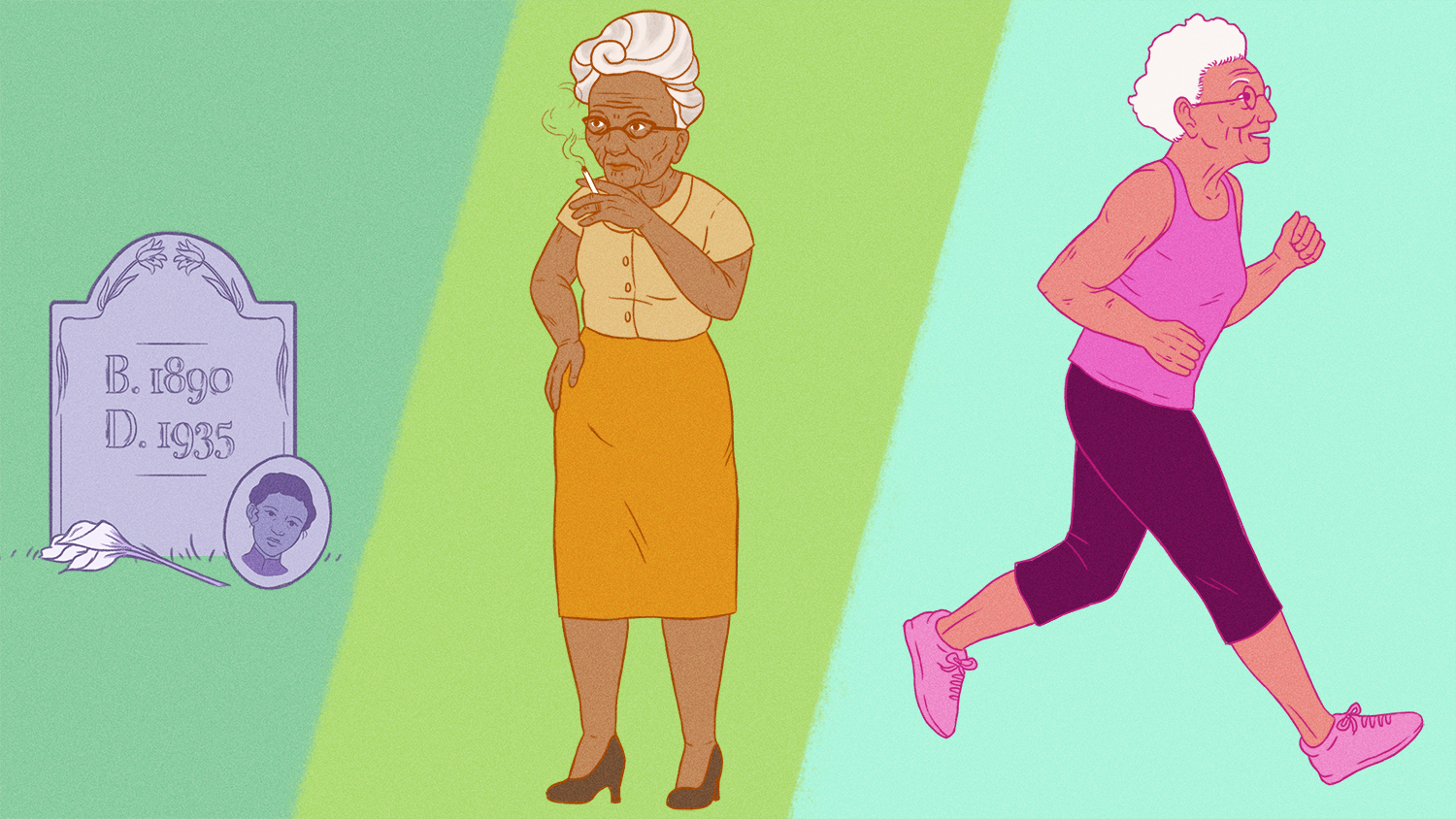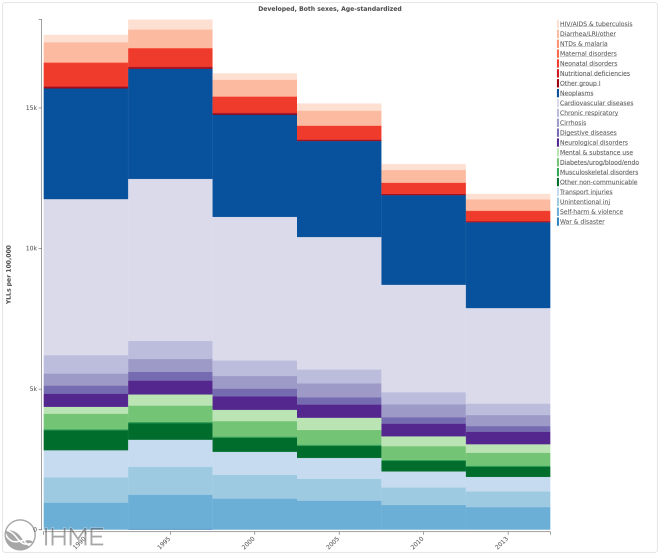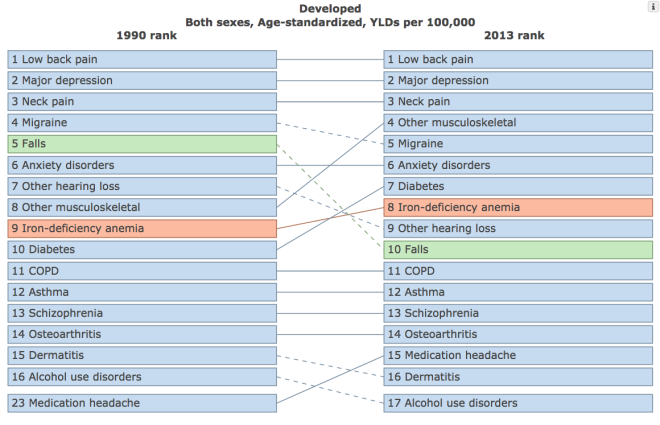Reading the news often leaves me with the sense that people are getting less healthy, but that’s just not the case. An article recently published in The Lancet offers a look at global health trends, and the news is pretty darn good.
“Worldwide, from 1990 to 2013, life expectancy at birth rose by 6.2 years,” the authors write. An extra six years of life per person, in a little more than two decades! That’s staggering to me.
But wait: People are living longer, but does that mean that we are squeezing in a few more years by keeping people alive while hooked up to life support, or in end-stage dementia, or staggering around with diabetes? Well, there has been an increase in the years people live with disabilities, but even after you adjust for those years lived with disabilities, we are still living more healthy years: Health-adjusted life expectancy rose 5.4 years. (Health-adjusted life expectancy is a measure of the “number of years of life expected to be lived in full health.”)
The Institute for Health Metrics and Evaluation (IHME), at the University of Washington, performed this global checkup with impressive attention to detail. Of course, any attempt to capture all human health data is going to contain generalizations. But as I’ve watched IHME over the last several years, I’ve been impressed by its methods. If you want to look at global health trends with data, rather than myths and stories, IHME is the place to look.
The data shows that the world is getting sicker in some ways and healthier in others. And these health trends are very clearly linked to development. Development usually means building power plants, industrializing food systems, and constructing cities. With development, infectious diseases and childhood mortality take a nosedive, but there’s a lot more obesity, back pain, and auto wrecks.
I’ve frequently wondered about these trade-offs. We have engineered the world for our own comfort by introducing a host of technologies that keep us safe, warm, and well fed. But because of this reengineering, we no longer live in the environment that our bodies evolved for: We eat food packed with calories and lacking in fiber, we sit all day, and we introduce hundreds of new chemicals to our lives. Are we progressing, or just trading one devil for another?
The data from IHME can provide some perspective on this question. Anyone can examine the IHME data from thousands of different angles using this visualization tool, so let’s take a look.
Globally, it’s clear that people are living longer. Here are the years of life lost (YLLs) per 100,000 people:
There are fewer deaths thanks to more vaccinations, hospitals, and sewer systems in poorer countries. Nigeria just eliminated polio, leaving the disease only in Afghanistan and Pakistan.
These are the sort of problems we know how to solve. What about the richer, more developed countries where we’ve mostly fixed those problems? Well, we see a positive trend there, too.
Notice that in this chart the cool colors — dark blue, greens, and purples — dominate. Many of these are sicknesses and injuries influenced by our high-tech environment, diseases of civilization: cancer, car crashes, heart disease, and diabetes. (The biggest two — neoplasms, i.e. cancers, and heart disease — look about the same in “developing” and “developed” countries; they just look bigger in this chart because they are a larger percentage of the whole. For apples to apples, see this chart.) Yet, as we’ve gained more civilization, we’ve been able to reduce the years of life lost to the diseases of civilization.
But that’s just death. What about all those things that make us miserable but don’t kill us? After all, we’ve gotten pretty good at saving lives, but that may mean we spend more time in chemotherapy or suffering from the ravages of obesity. Haven’t we gone from healthy noble savages to sickly schlubs? We can zero in on the years lost to disability (YLDs). And here, you can see, the trend is flat:

Click to embiggen. I’ve arranged this from highest to lowest, rather than by year, to help show that there’s no trend here — it just bounces around.
This is a real problem. We are great at saving lives in heroic, against-all-odds ways in the developed world. But we aren’t so good at preventing disease and helping people live healthier lives. And yet we’re not getting sicker — we’re just treading water. Here are the biggest health problems we face in terms of years lost to disability:
Again, these are the things that make us sick but don’t necessarily kill us. As it happens, as I write this, I’m dealing with a nasty case of lower back pain. Yesterday, I was crawling around on the floor. My body definitely didn’t evolve to sit in front of a computer for hours on end. But I’m thrilled to be dealing with back pain rather than influenza and hunger. All in all, this looks to me like good news. We’re not living with more sickness, and we have more years of life. I’ve focused on richer countries here, but the poorer countries have seen slightly larger gains in healthy life expectancy.
Now, you could argue that looking at human health is beside the point when planetary health is at risk. If climate change radically disrupts life on earth, all bets are off. But I think the long-term key to improving the environment will be ending poverty and stabilizing population. In The Lancet paper, researchers noted that as countries gained wealth, along with the diseases of civilization, their fertility rates dropped. That’s probably not a fast enough solution for climate change, but it certainly is part of the solution.
In this era, many people are concerned that we are somehow fundamentally messing up our health. We in the media fan the flames by focusing on the problems. It’s a lot easier to sell a story about the rise of a new disease than a story about healthy communities thriving peacefully.
So, sure, there’s plenty of room for improvement, and there are ways that health is getting worse. (The biggest problems have to do with food.) But if we care about data, the numbers suggest that our health really is getting better overall. Just think: five more years of life to read, to think, to watch movies, and to hug the ones we love. What a time to be alive! Yes, we must grapple with the diseases of civilization now. But if comes down to a crude choice between more civilization and less, the evidence suggests that we should opt for more.






